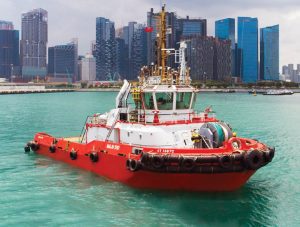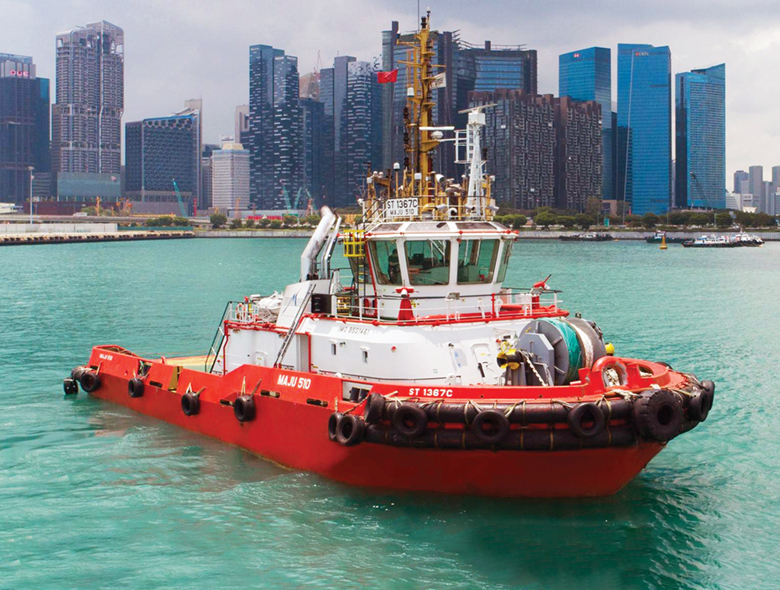
Image: Keppel Offshore & Marine.
Singapore-based Keppel Offshore & Marine announced in April that it has achieved several industry ‘firsts’ with the successful completion of its maiden autonomous vessel project.
Capable of autonomous vessel navigation as well as collision detection and avoidance, the Maju 510 tug, owned and operated by Keppel Smit Towage, is the first vessel in the world to receive the Autonomous Notation from ABS classification society, according to Keppel O&M.
“The tug is the first in South Asia that can be remotely operated by joystick control,” Keppel said in a statement. “It can be controlled from the shore command center with a joystick even for complex maneuvers, and was the first vessel in the world to receive the ABS Remote Control Navigation Notation in October 2021.”
It is also, according to the company, the first vessel to receive the Smart (Autonomous) Notation under the Singapore Registry of Ships by the Maritime and Port Authority of Singapore. This certifies the tug’s ability to perform autonomous and remote control navigation in a controlled environment with seafarers on board.
“Autonomous vessels and technologies have immense potential to transform the nature of maritime operations. We are pleased to be setting new records and industry standards at global scale with the completion of Keppel O&M’s first autonomous tug,” Keppel O&M CEO Chris Ong said.
“With in-depth engineering expertise and extensive retrofitting experience, Keppel O&M is able to customize autonomous solutions for a range of vessels,” he continued. “This includes digitalizing onboard systems and processes, modifying the vessel, as well as integrating best-in-class technologies and enhanced systems connectivity.”
Maritime and Port Authority of Singapore Chief Executive Quah Ley Hoon said that Singapore’s “regulatory sandbox” for Maritime Autonomous Surface Ships allows industry players like Keppel Offshore & Marine to develop and demonstrate smart navigation capabilities in port waters.
“We are pleased that under the (Singapore Registry of Ships), the tugboat Maju 510 has received the first Smart (Autonomous) D2B notation,” she said. “We will continue to collaborate with our industry partners to advance the deployment of autonomous vessels in the Port of Singapore.”
“Autonomous and remote operations enhance the efficiency and safety of tug operations by adding value with additional traffic and situational operational information,” Keppel Smit Towage Managing Director Romi Kaushal said. “This allows the tug captain and crew to focus on the more crucial tasks of safe tugging operations. We look forward to working with MPA and Keppel O&M to test and deploy more of the tug’s autonomous capabilities.”
Keppel O&M, through its technology arm, Keppel Marine and Deepwater Technology, set up a shore command center and upgraded the 65-ton bollard pull Maju 510 by retrofitting advanced systems to generate digital situational awareness and high accuracy positioning and maneuvering.
The Maju 510 was outfitted by Keppel O&M with state-of-the-art systems and technologies, including ABB Ability Marine Pilot Vision and Marine Pilot Control, which use artificial intelligence to automate navigational observations, fusion of data from different sources, risk assessment, decision making and vessel control.
The tug was also outfitted with various technologies that Keppel Marine and Deepwater Technology developed in partnership with the Maritime and Port Authority of Singapore and the Technology Centre for Offshore and Marine, Singapore, such as a Digital Twin which simulates vessel behavior in multiple scenarios.
Following the completion of the autonomous tug, Keppel O&M and Keppel Smit Towage say, they aim to test varying degrees of autonomous operations, including interaction and collaborative operations among autonomous vessels, tests in live traffic, remotely supervised autonomous operation with improved port connectivity, and pushing and towing operations.

